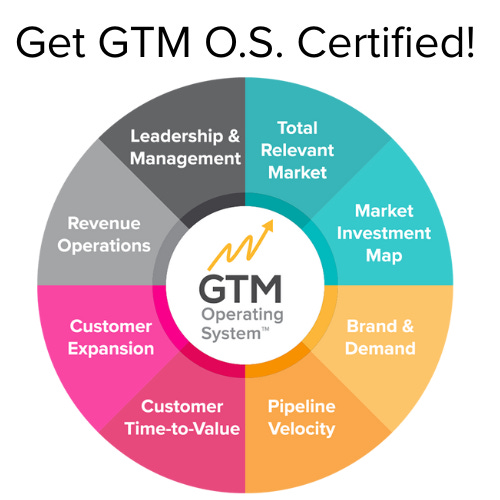What Breaks GTM at Scale (Part 1/2)
Point of View, Misalignment, and Prioritization Aren't All One Team's Fault
Thanks for being one of over 175,000 forward-thinking GTM Leaders who subscribe to this weekly research note.
This week’s research note includes:
GTM Research: What Breaks GTM at Scale (Part 1/2)
GTM OS Certified Partner Spotlight: Swetha Sirupa, iitA
GTM Leadership Awards: Submissions Close Sept. 26!
Upcoming Events and Access
Research: What Breaks GTM at Scale (Part 1/2)
Every GTM leader eventually runs into the same roadblocks.
Whether you’re at $15M, $50M or $3B ARR, the patterns are consistent.
These aren’t hypothetical problems. We’ve run more than 100 workshops executive teams across SaaS, supply chain, fintech, and more, and the same 15 problems come up again and again.
Functional leaders experience these problems every day: churn, POV, prioritization. Boards and CEOs, though, experience them differently: as big-picture “Valleys of Death” that threaten growth.
The disconnect often creates finger-pointing. “It’s sales’ fault. It’s marketing’s fault.” We even created a GTM Blame Bingo for your next team meeting!
Here’s the truth: these problems are not functional failures—they’re GTM failures.
They can only be solved when Sales, Marketing, Product, and Customer Success tackle them together.
Here are four of the most common GTM problems, what usually gets blamed, and what to actually do about them. Next week, we’ll share four more.
Do any of these resonate?
1. Your Point of View Isn’t Differentiated
The problem: If your messaging sounds like everyone else’s, buyers have no reason to listen.
Who gets blamed: Marketing takes the hit—“We need a better tagline” or “Demand gen isn’t working.”
The reality: Differentiation comes from a clear company purpose, a defined “enemy,” and explicit competitive advantages. That requires input from Product (what’s unique), Sales (what resonates), and CS (what customers actually value).
Diagnostic question to ask: If you asked 10 people in your company what you do, would you get the same answer?
Your next move: Build a point of view anchored in customer change, not just copywriting. Make sure the whole org can articulate it the same way.
Learn more about how to create a unique point of view.
2. You’re Struggling to Go from a Product Company to a Platform Company
The problem: You’ve built a strong product, but growth stalls when customers don’t see the bigger platform vision.
Who gets blamed: Product—“We need more features, integrations, or categories.”
The reality: Moving from product to platform is a GTM challenge, not a product problem. Marketing needs to reframe positioning, Sales must sell the vision, and CS has to reinforce multi-persona value.
Diagnostic question to ask: Does your platform expansion require new personas? Or are you simply adding more features for the same buyer?
Your next move: Treat expansion into new personas or categories like starting a new business. Don’t assume existing awareness will carry you.
Learn more about the 3P’s (Problem-Market Fit, Product-Market Fit, and Platform-Market Fit).
3. Sales, Marketing, and CS Are Out of Sync
The problem: Customers feel the seams when GTM teams act like separate planets.
Who gets blamed: Sales blames Marketing for bad leads. Marketing blames Sales for not following up. CS gets sidelined until renewal.
The reality: This is an executive alignment issue, not a pipeline issue. Without clarity on ICP, account lists, and shared goals, everyone creates their own version of success.
Diagnostic question to ask: How would Sales describe their relationship with Marketing? How would CS describe their relationship with Sales?
Your next move: Establish a single source of truth: ICP, pipeline contribution goals, and a unified GTM scorecard. Customers should feel one motion, not three.
5 questions to diagnose why sales, marketing, and CS are out of sync.
4. You Can’t Prioritize or Say No to New Initiatves
The problem: The team is drowning in ideas, requests, and pet projects.
Who gets blamed: Marketing for moving too slow, Product for backlog delays, or Ops for “blocking.”
The reality: Prioritization is an executive function. Without a decision framework, functional teams spin up their own metrics and chase shiny objects.
Diagnostic question to ask: Does your planning process provide clarity, alignment, and team accountability—or just a long list of “good ideas”?
Your next move: Limit your executive scorecard to no more than 25 metrics. Sequence opportunities instead of trying to chase them all.
Enroll in GTM University
These first four problems (undifferentiated POV, product vs. platform, siloed teams, and lack of prioritization) are often the earliest warning signs of GTM immaturity. They feel functional at first, but the reality is they cut across the entire revenue engine.
The companies that scale through them don’t just “fix messaging” or “hire more people.” They step back, align leadership, and treat GTM as a system.
That’s exactly why we created GTM University. Inside, we teach leaders how to move beyond finger-pointing and build the operating cadence, frameworks, and cross-functional plays that turn problems into growth levers.
If your team is wrestling with one (or all!) of these issues, GTM University is where you’ll learn how to go from insight to execution.
Certified Partner Spotlight: Swetha Sirupa, iitA
From Strategic Chaos to Executional Clarity
When growth stalls or strategic priorities shift, many companies get stuck in the gap between idea and execution. Swetha Sirupa, founder of iitA, helps startups and scale-ups close that gap—bringing clarity, alignment, and traction to their go-to-market efforts.
With over 15 years of experience across marketing, product, and growth strategy, Swetha works closely with CEOs and GTM leaders to navigate complex transitions, accelerate execution, and build scalable GTM engines. Her unique approach blends the structure of the GTM Operating System with hands-on workshops and deep implementation support—ensuring strategy doesn't just sound good on paper, but drives real results.
Whether you’re redefining your ICP, entering new markets, or aligning a cross-functional team around shared KPIs, Swetha helps you move fast—with confidence.
Core Offerings:
GTM Advisory – Co-create actionable strategy using GTM OS frameworks
GTM Implementation – Operationalize GTM across teams, pipeline, and positioning
Workshops & Executive Alignment – Facilitate GTM resets, ICP refinement, and cross-functional clarity
Ready to turn ideas into action?
Learn more: Swetha Sirupa Partner Page →
If you’d like to be a certified GTM Partner like Swetha and more than 40 others, we’d love to talk to you about how to make that happen.
GTM Leadership Awards: Submissions Close Sept. 26!
We’re excited to share that the GTM Leadership Awards are in full swing and nominations are open until September 26.
The awards are designed to spotlight the often-unsung operators—RevOps, MarketingOps, SalesOps, and CX Ops leaders—who turn GTM strategy into scale.
Forty of the top ops leaders in the industry will be recognized, with an incredible panel of judges (including Sangram!) helping to guide the process.
👉 Nominations close September 26. If you know someone building the future of GTM ops, now’s the time to submit.
Upcoming Events: Where We’ll or a GTM Certified Partner Will Be Speaking in 2025
(DM Sangram for a discount code to attend or to get slides after the talk)
Accelerate 2025 (hosted by VisionLink), September 25, Virtual
Fix Your Revenue Leaks - A GTM Workshop (hosted by GTM Certified Partner Sandy Yu) is running 7 city roadshow on 15 GTM problems in a city near you and there are 5 more to go: Amsterdam (Oct. 9), Copenhagen (Oct. 16), Singapore (Nov. 4), New York City(Nov. 13), Melbourne (Dec. 3)
GTM 2025 (hosted by Pavilion) in Washington, DC (this week! Sept.23-25)
Usage Economy Summit (hosted by LogiSense) Nov 5, San Francisco
Love,
Sangram and Bryan
p.s. Access GTM University | Hire GTM OS Certified Partners | Read Fractional Friday
Thanks for reading GTMonday by GTM Partners!
Subscribe for free to receive new posts and support our research work.





The cross functional team mis-alignment alone is a major derailer. Great post!